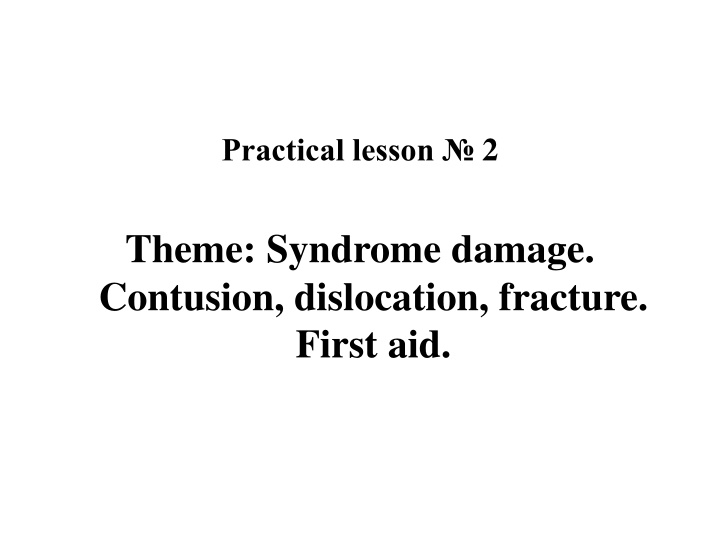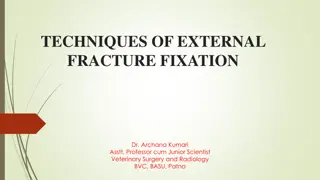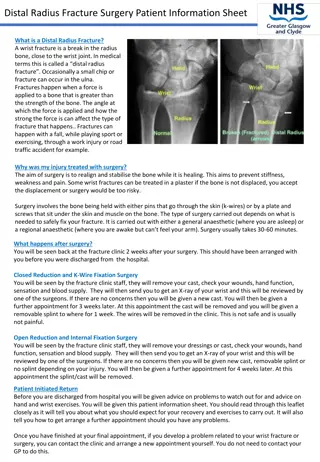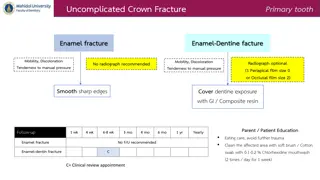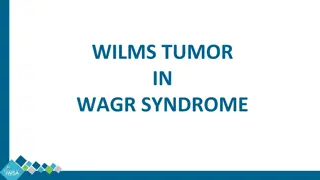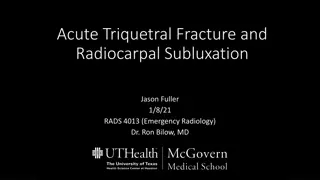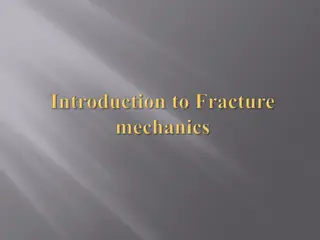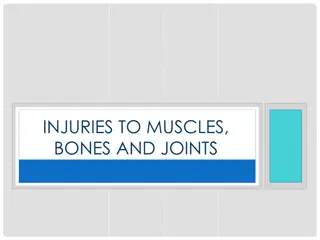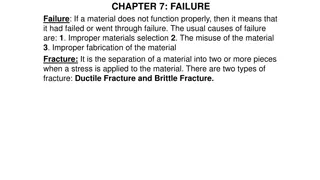Practical Lesson on Syndrome Damage: Contusion, Dislocation, and Fracture First Aid
Learn the definitions, causes, and symptoms of contusion, dislocation, and fracture in this practical lesson. Discover the basics of first aid, types of immobilization, and principles of transport immobilization. Equip yourself with the knowledge and skills to perform specific first aid treatments for various types of bone injuries. Clinical assessment techniques and equipment for transport immobilization are also covered. Enhance your ability to provide immediate assistance effectively in case of contusions, dislocations, and fractures.
Download Presentation

Please find below an Image/Link to download the presentation.
The content on the website is provided AS IS for your information and personal use only. It may not be sold, licensed, or shared on other websites without obtaining consent from the author.If you encounter any issues during the download, it is possible that the publisher has removed the file from their server.
You are allowed to download the files provided on this website for personal or commercial use, subject to the condition that they are used lawfully. All files are the property of their respective owners.
The content on the website is provided AS IS for your information and personal use only. It may not be sold, licensed, or shared on other websites without obtaining consent from the author.
E N D
Presentation Transcript
Practical lesson 2 Theme: Syndrome damage. Contusion, dislocation, fracture. First aid.
Learning objectives On completion of this practical lesson the learner will know: 1. The definition, cause, symptoms of Contusion, Dislocation, Fracture. 2. Basics of First aid. 3. The types of Immobilization. 4. The purpose of Immobilization. 5. Means (device) of immobilization. 6. Principles of Transport Immobilization. On completion of this practical lesson the learner will be able to do the following: 1. Perform the Application of kerchief to immobilize a fractured or dislocated shoulder. 2. Perform the Immobilization of fracture of forearm bones with Rigid Splint. 3. Perform the Immobilization of fracture of shoulder bones with Rigid Splint. 4. Perform the Immobilization of fracture of shin bones with Rigid Splint. 5. Perform the Immobilization of fracture of thigh with Rigid Splint.
Clinical assessment of the syndrome damage It must be emphasised again that an immediate assessment of the whole patient is required to exclude injuries to other systems before examination of the skeletal injury. Examination of the limb should determine: 1. whether there is a wound communicating with the fracture 2. whether there is evidence of a vascular injury 3. whether there is evidence of a nerve injury 4. whether there is evidence of visceral injury 5. Locate the Site of the Suspected Fracture. 6. Ask the casualty for the location of the injury: Does he have any pain? Where is it tender? Can he move the extremity? NOTE. With the presence of an obvious deformity, do not make the casualty move extremity. 7. Look for an unnatural position of the extremity. 8. Look for a bone sticking out (protruding).
Equipment to perform transport immobilization Splints. ) Standard medical Splints. ) Improvised Splints. Splints may be improvised from such items as boards, poles, sticks, tree limbs, or cardboard. If nothing is available for a splint, the chest wall can be used to immobilize a fractured arm and the uninjured leg can be used to immobilize (to some extent) the fractured leg. 2. Padding. ) Standard medical Splints have Padding. ) Improvised Padding. Padding may be improvised from such items as a jacket, blanket, poncho, shelter half, or leafy vegetation. 3. Bandages. ) Standard medical Bandages. ) Improvised Bandages. Bandages may be improvised from belts, rifle slings, kerchiefs, or strips torn from clothing or blankets. Narrow materials such as wire or cord should not be used to secure a splint in place. The application of wire and/or narrow material to an extremity could cause tissue damage and a tourniquet effect. 4. Slings. A sling is a bandage suspended from the neck to support an upper extremity. If a bandage is not available, a sling can be improvised by using the tail of a coat or shirt or pieces of cloth torn from such items as clothing and blankets. The triangular bandage is ideal for this purpose.
Equipment to perform transport immobilization . ) . ) . , , , , , . , ( ) .2. . ) . ) . , , , , . . ) . ) . , , , . , , . / . . - , . , , . .
Perform the Application of kerchief to immobilize a fractured or dislocated shoulder. 1. Prepare the victim for Splinting the Suspected Fracture. Reassure the victim. Tell him that you will be providing first aid for him and that medical help is on the way. Loosen any tight or binding clothing. Remove all jewelry from the injured part and place it in the casualty s pocket. Tell the victim you are doing this because if the jewelry is not removed and swelling occurs later, he may not be able to get it off and further bodily injury could result. 2. Position Casualty. The casualty may be either sitting up or lying down. 3. Gather Splinting Materials. Kerchief to immobilize. 4. Give limbs medium physical position. 5. Arm inserted in center of improvised sling. 6. Bring the ends of the sling up and tie them at the side of the neck on the uninjured side. 7 Twist and tuck the corner of the sling at the elbow. 8. Stay with the victim until the arrival of the doctor.
Perform the Application of kerchief to immobilize a fractured or dislocated shoulder.
Perform the Immobilization of closed fracture of forearm with Rigid Splint 1. Prepare the victim for Splinting the Suspected Fracture. Reassure the victim. Loosen any tight or binding clothing. Remove all jewelry from the injured part and place it in the casualty s pocket. 2. Position victim. The victim may be either sitting up or lying down. 3. Gather Splinting Materials. Standard medical Splints (Kramer's Splint with Padding). Before beginning first aid procedures for a fracture, gather whatever splinting materials are available. Ensure that splints are long enough to immobilize the joint above and below the suspected fracture. 4. Model a splint on a healthy limb. 5. Give a limbs medium physical position - bent the elbow joint at an angle of 90 degrees, turn the palm to stomach, fingers slightly bent. 6. Place a splint from the fingertips to middle of the shoulder. 7. Fix the splint on full length with the same pressure with spiral bandage. 8. Perform the Application of kerchief.
Perform the Immobilization of closed fracture of forearm with Rigid Splint. 1. . . . .. 2. . . 3. . ( ). , . , , . 4. . 5. . 6. . 7. . 8. .
Immobilization of fracture of shoulder bones. Application of Rigid Splint. 1. Prepare the victim for Splinting the Suspected Fracture. Reassure the casualty. Loosen any tight or binding clothing. Remove all jewelry from the injured part and place it in the casualty s pocket.. 2. Position victim. The victim may be either sitting up or lying down. 3. Gather Splinting Materials. Standard medical Splints (Kramer's Splint with Padding). Before beginning first aid procedures for a fracture, gather whatever splinting materials are available. Ensure that splints are long enough to immobilize the joint above and below the suspected fracture. 4. Model a splint on a healthy limb. 5. Give a limbs medium physical position. deflect the shoulder joint on 15-20 degrees (Put the cushion in the axilla), bent the elbow joint at an angle of 90 degrees, turn the palm to stomach, fingers slightly bent. 6. Place a splint from the fingertips to healthy shoulder. 7. Fix the splint on full length with the same pressure with Spica bandage on the shoulder. 8. Perform the Application of kerchief.
Immobilization of fracture of shin bones. Application of Rigid Splint. 1. Prepare the victim for Splinting the Suspected Fracture. Reassure the victim. Loosen any tight or binding clothing. Boots should not be removed from the victim. Exception - bleeding from the foot. 2. Position victim. The victim may be either lying down. 3. Gather Splinting Materials. 3 standard medical Splints (Kramer's Splint with Padding). Before beginning first aid procedures for a fracture, gather whatever splinting materials are available. Ensure that splints are long enough to immobilize the joint above and below the suspected fracture. 4. Model a splint on a healthy limb. 5. Give a limbs medium physical position - bend the knee angle of 140-160 degrees, to bend the ankle at an angle of 90 degrees. 6. Place a 1 splint from the fingertips to middle of the thigh at the back surface. 7 . Place a 2 splints from the ankle to middle of the thigh on each side. 8. Fix the splint on full length with the same pressure with spiral bandage.
Perform the Immobilization of fracture of thigh with Rigid Splint 1. Prepare the victim for Splinting the Suspected Fracture. Reassure the victim. Loosen any tight or binding clothing. Boots should not be removed from the victim. Exception - bleeding from the foot. 2. Position victim. The victim may be either lying down. 3. Gather Splinting Materials. 3 standard medical Splints (Kramer's Splint with Padding). Before beginning first aid procedures for a fracture, gather whatever splinting materials are available. Ensure that splints are long enough to immobilize the joint above and below the suspected fracture. 4. Model a splint on a healthy limb. 5. Give a limbs medium physical position - bend the knee angle of 140-160 degrees, to bend the ankle at an angle of 90 degrees. 6. Place a 1 splint from the fingertips to buttocks at the back surface. 7. Place a 2 splint from the axilla to ankle on the lateral surface of leg. 8. Place a 3 splint from the from groin to ankle on the internal surface of leg. 9. Fix the splint on full length with the same pressure with spiral bandage.
